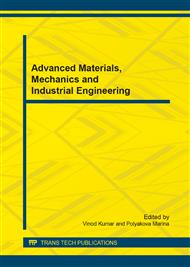[1]
Sander, F. (1963), On subjective probability forecasting, Journal of Applied Meteorology, 2, 191-201.
Google Scholar
[2]
V. N. Phat and K. Ratchagit, Stability and stabilization of switched linear discrete-time systems with interval time-varying delay, Nonlinear Analysis: Hybrid Systems, Vol. 5 (2011), pp.605-612.
DOI: 10.1016/j.nahs.2011.05.006
Google Scholar
[3]
K. Ratchagit, Asymptotic stability of delay-difference system of Hopfield neural networks via matrix inequalities and application, International Journal of Neural Systems, Vol. 17 (2007), pp.425-430.
DOI: 10.1142/s0129065707001263
Google Scholar
[4]
V. N. Phat, Y. Khongtham and K. Ratchagit, LMI approach to exponential stability of linear systems with interval time-varying delays, Linear Algebra and its Applications, Vol. 436 (2012), pp.243-251.
DOI: 10.1016/j.laa.2011.07.016
Google Scholar
[5]
M. Rajchakit and G. Rajchakit, Mean square exponential stability of stochastic switched system with interval time-varying delays, Abstract and Applied Analysis, Volume 2012 (2012).
DOI: 10.1155/2012/623014
Google Scholar
[6]
Fritz, R., Brandon, C., and Xander, J. (1984), Combination time-series and econometric forecast of tourism activity, Annals of Tourism Research, 11, 219-229.
DOI: 10.1016/0160-7383(84)90071-9
Google Scholar
[7]
Deutsch M, Granger CWJ, Terasvirta T. 1997. The combination of forecasts using changing weights, International Journal of Forecasting 10: 47-57.
DOI: 10.1016/0169-2070(94)90049-3
Google Scholar
[8]
Stock JH and Watson MW. 2004. Combination forecasts of output growth in a seven- country data set, Journal of forecasting, 23, 405-430.
DOI: 10.1002/for.928
Google Scholar
[9]
M. Rajchakit, P. Niamsup and G. Rajchakit, A switching rule for exponential stability of switched recurrent neural networks with interval time-varying delay, Advances in Difference Equations, Vol. 2013 (2013: 44).
DOI: 10.1186/1687-1847-2013-44
Google Scholar
[10]
Clark, T.E. and McCracken, M.W. 2009. Combining Forecasts from Nested Models, Oxford Bulletin of Economics and Statistics, 71, 303-329.
DOI: 10.1111/j.1468-0084.2009.00547.x
Google Scholar
[11]
shujie shen, Gang Li and Haiyan Song. 2010. Combination forecasts of international tourism demand, Annals of tourism research: ATR ; a social sciences journal; 38.
DOI: 10.1016/j.annals.2010.05.003
Google Scholar
[12]
K. Ratchagit, Asymptotic stability of nonlinear delay-difference system via matrix inequalities and application, International Journal of Computational Methods, vol. 6 (2009), pp.389-397.
DOI: 10.1142/s0219876209001899
Google Scholar
[13]
Agnew, C.E. (1985), Bayesian consensus forecasts of macroeconomic variables, Journal of Forecasting, 4, 363-376.
DOI: 10.1002/for.3980040405
Google Scholar
[14]
M. Rajchakit and G. Rajchakit, LMI approach to robust stability and stabilization of nonlinear uncertain discrete-time systems with convex polytopic uncertainties, Advances in Difference Equations, vol. 2012 (2012: 106).
DOI: 10.1186/1687-1847-2012-106
Google Scholar
[15]
Reeves, G.R., and Lawrence, K.D. (1982), Combining multiple forecasts given multiple objectives, Journal of Forecasting, 1, 271-279.
DOI: 10.1002/for.3980010306
Google Scholar
[16]
Winkler, R.L., and Makridakis, S. (1983), The combination of forecasts, Journal of the Royal Statistical Society, Series A, 146, 150-157.
DOI: 10.2307/2982011
Google Scholar
[17]
Mills, T.C., and Stephenson, M.J. (1987), A time series forecasting system for the UK money supply, Economic Modeling, 355-369.
DOI: 10.1016/0264-9993(87)90009-5
Google Scholar
[18]
Russell, T.D., and Adam, E.E., Jr, (1987), An empirical evaluation of alternative forecasting combinations, Management Science, 33, 1267-1276.
DOI: 10.1287/mnsc.33.10.1267
Google Scholar
[19]
R.P. Agarwal, Difference Equations and Inequalities, Second Edition, Marcel Dekker, New York, (2000).
Google Scholar
[20]
S. Boyd, L. El Ghaoui, E. Feron and V. Balakrishnan, Linear Matrix Inequalities in System and Control Theory, SIAM, Philadelphia, (1994).
DOI: 10.1137/1.9781611970777
Google Scholar
[21]
Robert Andrawis, Amir F. Atiya, and Hisham El-Shishiny, 2011. Combination of long Term and short term forecasts, with application to tourism demand forecasting" International Journal of Forecasting, Vol. 27, No. 3, pp.870-886.
DOI: 10.1016/j.ijforecast.2010.05.019
Google Scholar


